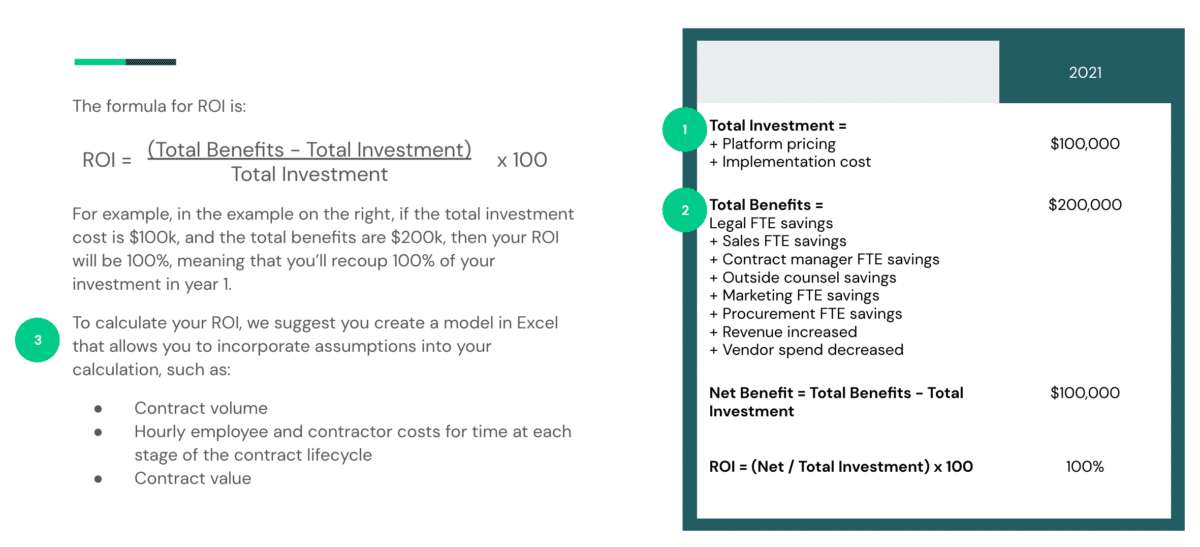Ninety percent of legal teams admit they can’t keep pace with their contracts. This means missed deadlines, accumulated late fees, and unwanted automatic renewals all adds costs and drag down profit. Without transparency and oversight, managing your contracting process is expensive, time-consuming, and opens your business to risk.
Contracts power every transaction in the modern business. Every business has contracts. Managing them well is critical to success, yet proving the value of a CLM solution can be challenging for in-house or legal operations .
But one of the most frequent questions we get asked is how to determine if you need a contract lifecycle management (CLM) solution and the return on your investment (ROI) you should expect.
What is CLM and why does your business need it?
Companies invest in contract lifecycle management (CLM) solutions because both the volume of contracts and the pace of modern business continues to increase. Your contracts dictate the speed of business: when your contracts are fast, your business is fast. When your contracts are slow, your business is slow.
With the right CLM solution, companies can streamline their contract management process and create a single source of truth for contracts and data so they can:
- Fast-track contracts by transforming manual contracts into digital workflows
- Negotiate better agreements by streamlining internal and external collaboration between parties
- Illuminate and unlock contract data, improve outcomes by understanding the most underutilized source of actionable business data
If you’ve ever had to create a contract or manage the contract process at your company, you’ve most likely run into outdated contracts, slow approval processes, and manually tracking contracts in a spreadsheet. The pain points are easy to identify, but how do you know you’re making the right investment? And how do you prove the value of contract lifecycle management?
“At Mastercard, we set a long-term roadmap to tell the story of what we’re trying to solve for. Ironclad created operational efficiencies as they related to business impact.”
— Anushree Bagrodia, Legal Transformation Lead and Senior Managing Counsel, Mastercard
Should you invest in CLM?
The short answer is yes.
The key to determining when you should invest in CLM and which platform to choose, starts by evaluating your current process. Think about everyone in your organization who touches a contract and all the steps of the contract journey—from creation, review, signature, and storage. Every pain point and risk in the process is a potential opportunity to drive better results for your team and the overall business.
Start by asking the following questions to identify key pain points in your current process:
- How much time is your team, including in-house counsel and legal ops, devoting to managing contracts instead of focusing on strategic initiatives and high-value tasks?
- Has the mismanagement of a contract ever led to a missed sales opportunity or stalled a business deal?
- Has a sales person ever sent an outdated sales form, NDA, or SOW to a prospect?
- Do your contracts suffer slow turnaround times because your Is your legal department burdened or lack the tools necessary for faster review and ratification?
- Are other departments in the business (marketing, sales, procurement, etc.) excited and willing to work with the legal team, or do they view your legal department as a roadblock to productivity?
- Do you depend on expensive outside counsel to manage your contracts?
- What is the risk level—both financially and legally—of your contracts, and are you managing those risks effectively?
Now that you’ve identified the pain points and areas for improvement in your current process, you should map each one to the value your company would get from investing in a CLM solution.
“The legal team are our friends here. A process that could have taken weeks, can now be spun up within minutes. That brings a whole lot of ROI and value to an organization.”
— Kevin Staniszewski, Mid-market Sales Lead, Asana
Value for your entire business
Proving CLM’s value comes down to the two main drivers behind most business decisions: time and money. With the right CLM solution, companies can close deals faster, reduce contract management expenses (including outsourced legal fees), and use better renewal management to avoid late fees and renegotiate better terms with vendors and clients.
Improved efficiency
- Eliminate manual tasks so your team can focus their time and resources on strategic initiatives
- Faster cross-functional collaboration and negotiations
- Rapid approvals and signature workflows, with context-aware collaboration
- Empower every team with self-service contract creation
Increased revenue
- Enhanced deal management, including fast-tracking deals and closing deals quickly and efficiently
- Improve renewal management and contract renewal terms
- Negotiate better outcomes for your contracts
- Decrease over-payments, law firm fees, and vendor spend
Reduced risk
- Avoid using outdated or unapproved contract templates
- Ensure the correct data is included in each individual contract
- Track versions and deadlines and maintain an complete audit trail
- Ensure valid signatories on all deals and the correct level of governance over what’s being agreed to
- Intelligently monitor and manage contractual obligations, key dates, meta data, etc.
- Maintain uniformity in your legal position
Calculating ROI for CLM
ROI is your financial analysis of how much value your CLM will create across your business.
The ROI model is built on the following core components:
- Investment costs: What are the hard and soft costs for your CLM?
- Benefits: What are the hard and soft business gains likely to be realized from your CLM, particularly as they are related to revenue?
- Assumptions: What assumptions are you making that might affect your calculation? Examples: contract volume, hourly employee and contractor costs, contract value
Here’s an example…
CLM is easier than you think
After you’ve determined if CLM is a good investment, you need to pick the right partner.
By partnering with Ironclad, businesses can leverage a powerful CLM platform, enabling:
- Faster contract creation
- Improved collaboration
- Unlocked contract data
- Ease of use & implementation
Implementation and adoption are two pillars of the software evaluation process that are often overlooked. Partners in your success, we’ve designed Ironclad’s implementation program to get you up and running as quickly as possible on our digital contracting platform.
Get our CLM implementation guide to learn how to go from kick-off to roll-out in 60 days—5x faster than the industry standard for contract management systems.
Ironclad is not a law firm, and this post does not constitute or contain legal advice. To evaluate the accuracy, sufficiency, or reliability of the ideas and guidance reflected here, or the applicability of these materials to your business, you should consult with a licensed attorney. Use of and access to any of the resources contained within Ironclad’s site do not create an attorney-client relationship between the user and Ironclad.
- What is CLM and why does your business need it?
- Should you invest in CLM?
- Value for your entire business
- Calculating ROI for CLM
- CLM is easier than you think
Want more content like this? Sign up for our monthly newsletter.




